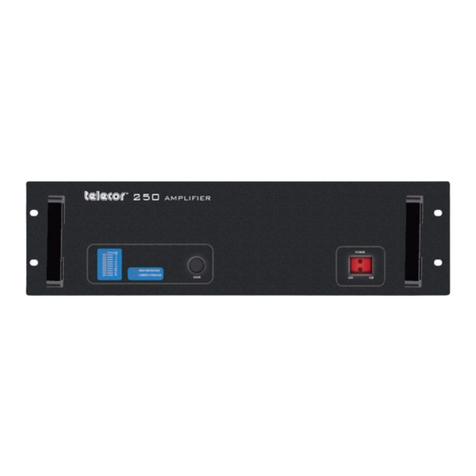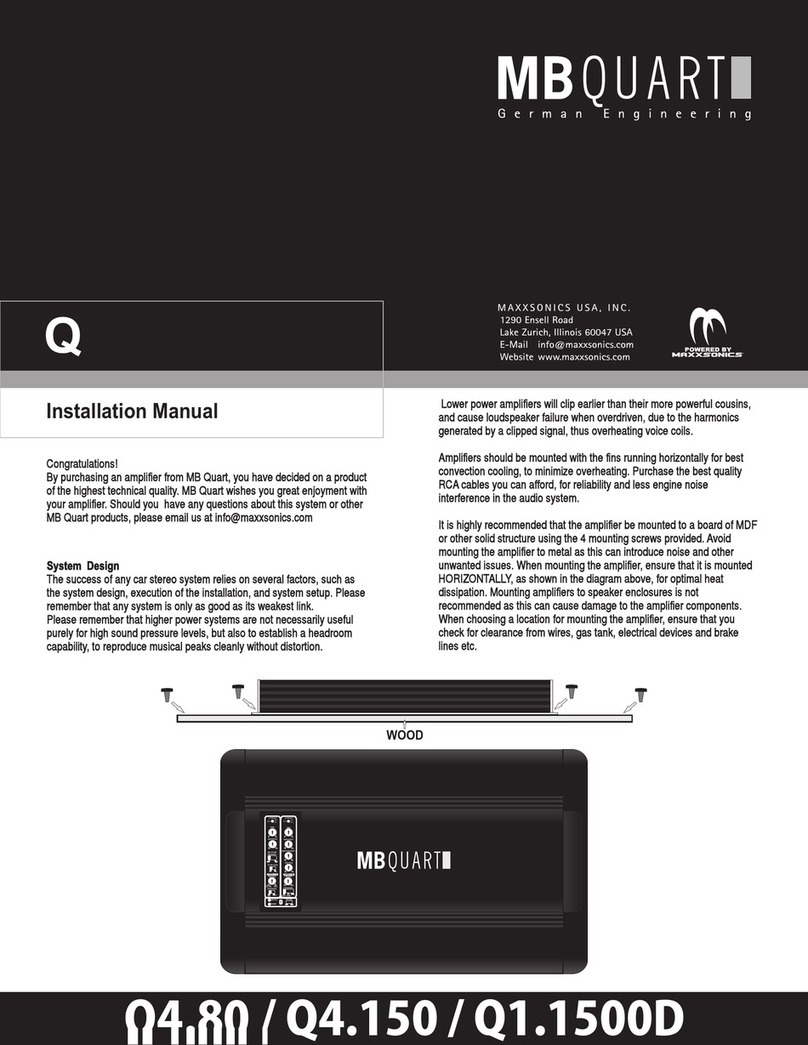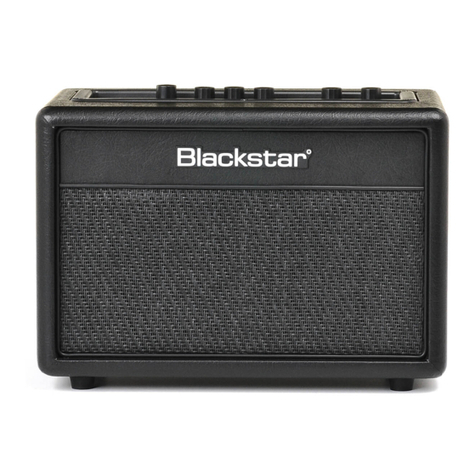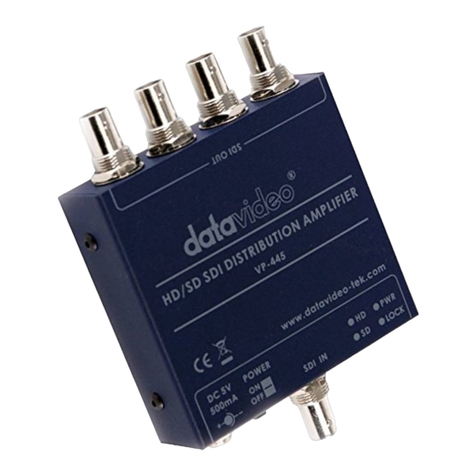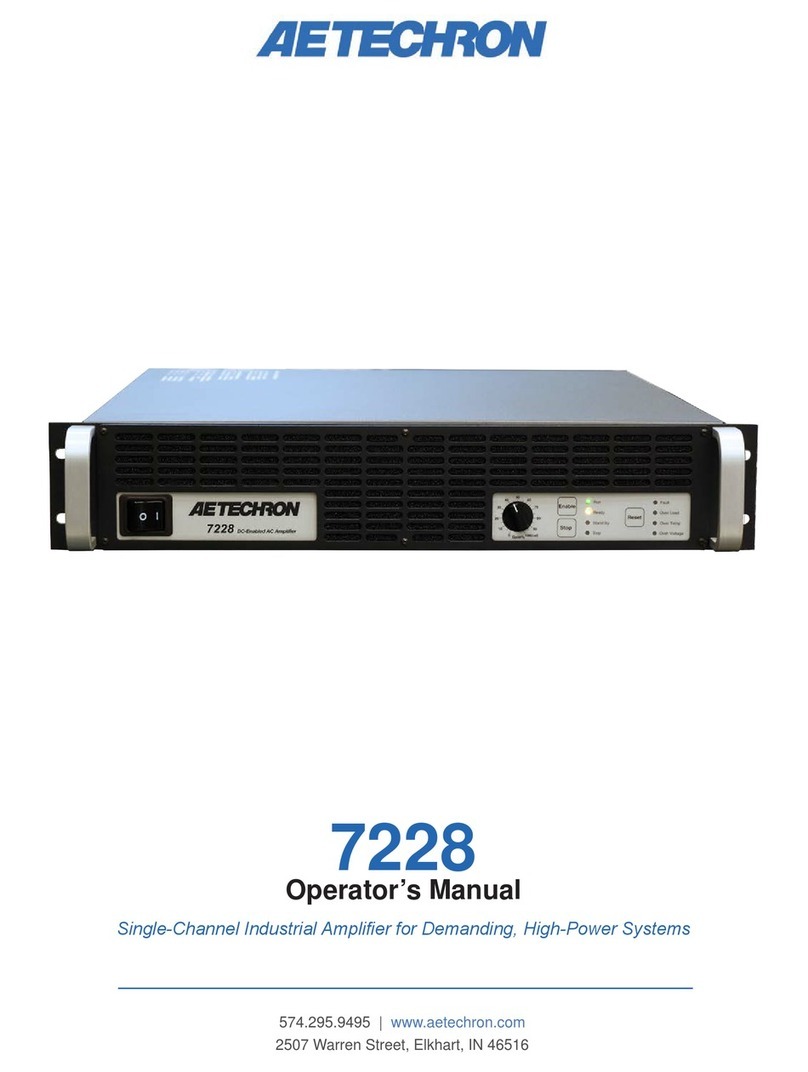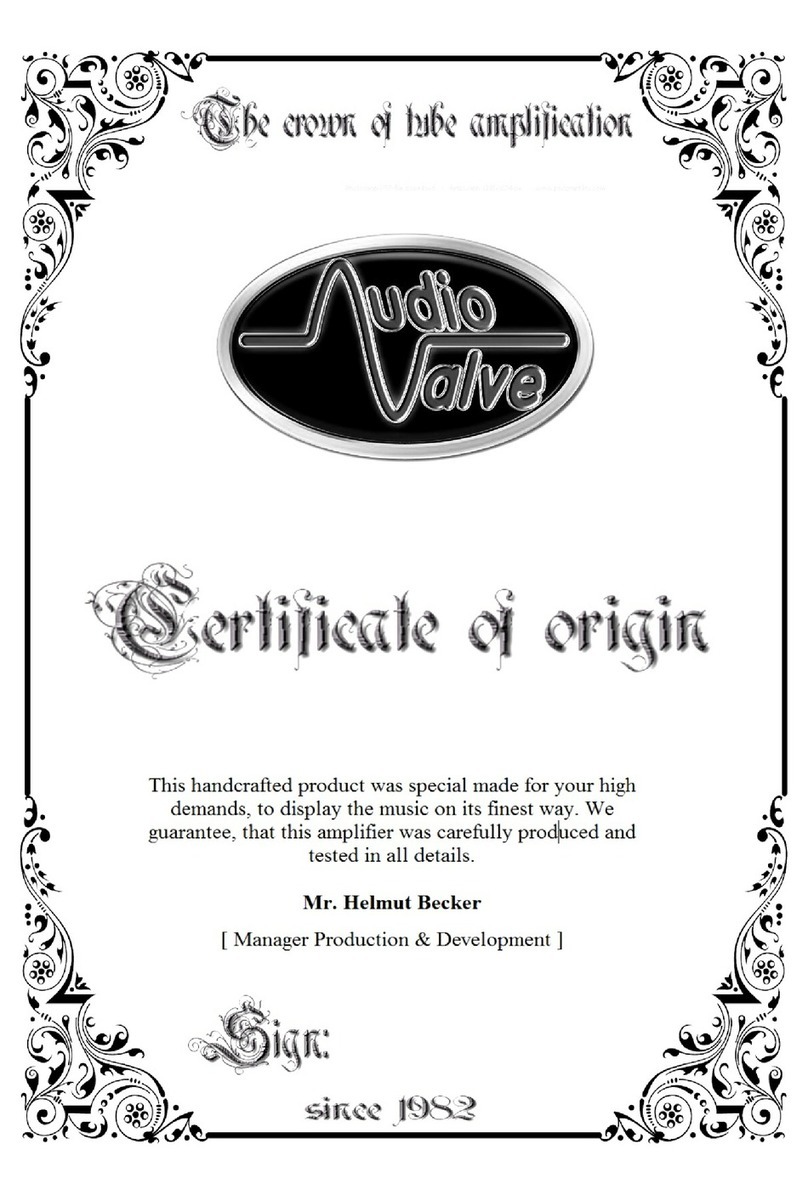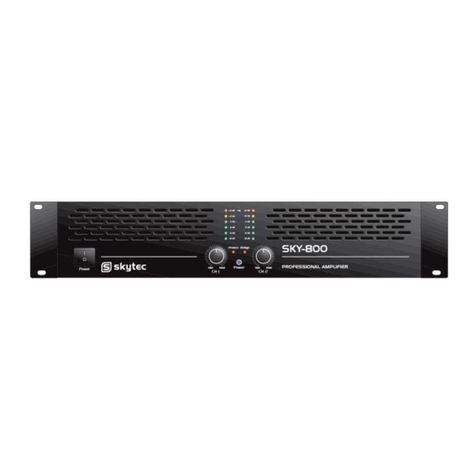Telecor SI-125 User manual

SI-125 Power Amplifier Manual 1
SI-125
Power Amplifier Manual
6205 Kestrel Road; Mississauga, Ontario; Canada; L5T 2A1 November 2016, Rev 0.5
Phone: (905) 564-0801 Fax: (905) 564-0806 www.telecor.com E:\T2-108\T2-M108-ABC\T2-M108-B.doc/AD
The Telecor SI-125 Power Amplifier delivers 125 watts of audio power intended to drive
industry standard speakers for sound reinforcement and paging systems. The amplifier will
accept either a balanced or single-ended input source. A sensitivity Input Level switch is
provided to select either the 1 V (0 dB) or 100 mV (-20 dB) input level. Output terminals are
provided for 4 Ω, 8 Ω, 25 V and 70 V speaker lines. The amplifier contains current limiting
circuitry on the output to protect it from overloading. The amplifier also has circuitry to protect it
from overheating.
The SI-125 Power Amplifier can have optional modules installed for additional functionality.
The PA-AM Power Amplifier Attenuator Module allows the amplifier to support a 25 V input
signal. The PA-MM Power Amplifier Monitor Module activates a relay under normal amplifier
operation. The PA-PM Power Amplifier Paging Module provides the amplifier with additional
inputs for a low impedance microphone and two balanced line level inputs.
The SI-125 Power Amplifier conforms to UL 60065 ETL listed mark with listing number
3059290.
The following symbols are on the amplifier and in this manual:
CAUTION
These servicing instructions are for use by qualified service personnel only. To reduce the risk
of electric shock, do not perform any servicing other than that contained in the operating
instructions unless you are qualified to do so.

SI-125 Power Amplifier Manual 2
Unit Description
The various amplifier parts are:
Figure 1: SI-125 Front View
A. VU METER: The 30 dB digital VU meter shows 0 dB when the amplifier is operating at
its rated output. Exceeding the rated output will cause the output to be clipped, which will
be indicated by the illumination of the CLIP light.
B. HIGH TEMPERATURE Light: If the internal temperature of the amplifier exceeds its
normal operating limit, the High Temperature light will illuminate and the output level
will begin to be reduced. The amplifier will continue to operate at a reduced output level
until the temperature returns to an acceptable level. If the High Temperature light
illuminates, see the Troubleshooting section.
C. CURRENT OVERLOAD Light: If the current output of the amplifier exceeds its
maximum power output, the Current Overload light will illuminate and the output level
will begin to be reduced. The amplifier will continue to operate with the current limiting
circuit reducing the output power. If the Current Overload light illuminates, see the
Troubleshooting section.
D. GAIN Control: The gain of the amplifier can be adjusted using this potentiometer. The
potentiometer is concealed behind a snap-on cover. The cover can be snapped off when
the level needs to be adjusted but should be replaced to prevent unintended tampering.
The amplifier gain is set by both this control and the sensitivity Input Level switch on the
back of the amplifier.
E. POWER Switch: Turns the amplifier on and off. The switch will illuminate when the
amplifier is turned on.
Figure 2: SI-125 Rear View

SI-125 Power Amplifier Manual 3
F. FUSE: Protects the amplifier if the maximum current draw is exceeded. If the fuse blows,
see the Troubleshooting section.
G. AC Power Cord: Connects the amplifier to a standard 120 V, 60 Hz grounded outlet.
H. OUTPUT TERMINALS: Terminals are provided for 70 V and 25 V speaker lines, as
well as 8 Ωand 4 Ωloads. Class 2 wiring may be used.
Ensure that the amplifier is OFF before making, removing or handling any
input or output connections. The output cover must be in place when the
amplifier is operating.
I. ACCESSORY MODULE SLOT (for optional accessories): Several accessory
modules are available, which may be installed into the amplifier. If no accessory module
is installed, a blank cover plate covers the slot.
Please note that the accessory modules are not user installable. They must be
factory installed and ordered with the amplifier. Do not remove any modules o
r
the cover plate.
J. INPUT LEVEL Switch: The Input Level switch selects the range of the input level. This
switch works in conjunction with the GAIN Control on the front of the amplifier. The
Input Level switch should be set to match the level of the input in either the 1 V or 100
mV (-20 dB) range.
K. LOW CUT Switch: The Low Cut switch will reduce the low-end frequency response of
the amplifier as shown in Figure 3.
Figure 3: Relative Level (dB) vs. Frequency (Hz)
L. INPUT TERMINALS: The input terminals are electronically balanced with an input
impedance of 10 kΩ. The input signal level should be in either the 1 V or 100 mV range
with the Input Level switch set to the appropriate position. The GND terminal is
provided, if required, for grounding the cable shield.

SI-125 Power Amplifier Manual 4
Clipping
Output Clipping is the point where the peak output signal is limited to avoid damage to the
amplifier from excessive output current (current overload). Once output clipping is detected, any
increases in input level will not cause increases in output level (this is shown by the output
plateau in Figure 4). To avoid distortion, the output signal is dynamically attenuated to give the
maximum attainable output voltage without distortion, although technically the peak output level
is clipped at this point. The Current Overload light will turn on when the current limiting
circuitry is engaged.
Figure 4: Effect of Clipping
Input Attenuation will occur when the signal is limited due to excessively high signal level at
the input. The clipping LED will turn on either when there is excessive signal level on the input
or when there is hard clipping present on the output. The CLIP light will not turn on when the
output level is clipped due to current overload.
Installation
Before installing an SI-125 Power Amplifier, carefully inspect the device for any damage that
may have occurred during shipping. The shipping package should contain only the Power
Amplifier. If any part of the amplifier has been damaged, please contact the shipping company as
soon as possible.
DO NOT ATTEMPT TO INSTALL EQUIPMENT THAT WAS RECEIVED
DAMAGED.
The amplifier mounts into a standard 19" Telecor equipment rack with 10-32 screws. The SI-125
requires 5 ¼" of vertical rack space. When mounting the amplifier into a rack with other
equipment, be sure to allow for adequate ventilation. To accomplish this, ensure that a blank
panel of 1 ¾" height (or greater) is installed between the amplifier and any other equipment (e.g.
additional amplifiers, power supplies, etc.) in the rack.

SI-125 Power Amplifier Manual 5
Do Not mount the amplifier such that:
•there is inadequate ventilation.
•the vents on the top, bottom or side of the amplifier are covered or blocked.
•it is susceptible to vibration.
•it is in an area of high ambient temperature.
•it is adjacent to other heat-radiating equipment.
•it is exposed to direct sunlight.
•it is exposed to moisture.
The amplifier should be plugged into a standard three-prong 120 V, 60 Hz grounded outlet. Turn
the Power Switch off when connecting or disconnecting the AC receptacle.
Ensure that the amplifier is OFF before making, removing or handling any input o
r
output connections. The output cover must be in place when the amplifier is operating.
Input Connections: The screw terminals on the right side of the back of the amplifier are for
signal input. The input terminals are suitable for both balanced and single-ended inputs. A
ground terminal is provided for grounding the shield of the cable if required. An example of
typical input wiring is shown in Figure 5.
Figure 5: Input Connections
To reduce the incidence of ground loop hum, oscillation, or interference from other audio
sources:
1. Use a shielded cable for input wiring. The shield must be grounded at one end of the
cable only, not both.
2. Regardless of what type of input signal is supplied to the amplifier (balanced or single-
ended), the GND terminal should not be connected to the – (common) terminal.
3. Do not enclose input and output connectors in the same cable. Where possible and
practical, and when the wire length exceeds 6 feet, the input and output wiring, in
addition to being separate cables, should be physically separated.
Set the Input Level switch to match the level of your input. If you are connecting the input of the
amplifier to an unknown level signal, set the Input Level switch to 1 V and the GAIN Control to
0, then apply the signal and increase the gain. If an unacceptable level is not reached with the
gain at maximum: turn the GAIN Control to 0, set the Input Level switch to 100 mV, and then
increase the gain.
Ensure that the amplifier is OFF before making, removing or handling any input o
r
output connections. The output cover must be in place when the amplifier is operating.

SI-125 Power Amplifier Manual 6
Output Connections: The left terminal strip is the signal output of the amplifier. Terminals are
provided for 70 V and 25 V speaker lines, as well as 8 Ωand 4 Ωloads. Connect the speaker
load to the appropriate terminals depending on the load impedance. Class 2 wiring may be used.
The output of the amplifier is floating with respect to ground and should remain that way. Do not
connect the COM and GND terminals together. The GND terminal is provided for use with
shielded cable only.
To reduce the incidence of output audio being induced into other conductors, use twisted pair
wiring and keep the input and output wiring separated. To avoid overloading the amplifier,
ensure that the total speaker load impedance is no less than the values in the table below:
Output Terminals Maximum Load /
Minimum Impedance
70 V 39 Ω
25 V 5 Ω
8 Ω8 Ω
4 Ω4 Ω
Line Impedance Measurements: Measure the amplifier’s load impedance using an audio signal
impedance meter (1 kHz) with the amplifier output disconnected. Also measure the impedance
of each side of the load to earth ground, which should be an open circuit. If it is not (i.e. there is a
fault to ground), isolate the fault and correct it. Do not operate the amplifier on a ground-faulted
output line.
Note: In school applications, there is often a privacy switch in the room. When this switch is
activated, it grounds one side of the room speaker line through a transformer. Make sure that all
these privacy switches are not in the Privacy position when measuring line impedance to ground.
These switches do not adversely affect the operation of the amplifier.
When measuring load impedance on a Telecor installation, disconnect the amplifier output from
the line, connect the impedance meter across the line, make sure the system is in an ALL CALL
mode, and then measure the line’s impedance and check for line ground faults.
Operation
•Before turning the amplifier on, ensure that:
othe speakers have an adequate power rating.
othe proper output terminals have been used.
othe gain of the amplifier is appropriate for the input signal supplied.
•If you are unsure about the Input Level and gain settings, turn the GAIN Control to
minimum before turning the amplifier on.
•Once the amplifier is mounted and wired, turn the unit on. The Power Switch will
illuminate. Watch the VU Meter on the front of the Power Amplifier. With no signal
connected, ensure that none of the LEDs are illuminated. If any LEDs illuminate, refer to
the Troubleshooting section
•With the signal applied, adjust the GAIN Control until an appropriate output level is
obtained. If the Current Overload or Clip lights illuminate, see the Troubleshooting
section
•To reduce the low frequency amplification, set the Low Cut switch to the CUT position.

SI-125 Power Amplifier Manual 7
Optional Modules
Additional functionality can be added to the SI-125 Power Amplifier with the factory installation
of one of the following optional modules.
Note: These modules must be ordered at the same time as the SI-125 Amplifier as they cannot be
installed in the field at a later time. These modules are installed on the rear of the amplifier by the
Telecor factory and therefore cannot be ordered independently without an amplifier.
The PA-AM Power Amplifier Attenuator Modules provides the amplifier with the ability to
support a 25 V input signal which is attenuated by -25, -45, or -70 dB. Refer to the PA-AM
Power Amplifier Attenuator Module Manual for more information.
The PA-MM Power Amplifier Monitor Module will monitor the operational status of the
amplifier. As long as the amplifier is operating normally, a relay will be activated. Refer to the
PA-MM Power Amplifier Monitor Module Manual for more information.
The PA-PM Power Amplifier Paging Module adds three additional input options to the
amplifier: one low impedance microphone and two balanced line level inputs. The three inputs
have adjustable level and remote mute controls. The three inputs can also be assigned to one of
three available priority levels. Refer to the PA-PM Power Amplifier Paging Module Installation
Guide for more information.
Troubleshooting
Problem Description
VU Meter registers a signal when
no signal should be present.
The amplifier may be oscillating, possibly at a very high frequency.
This may be caused by: running input and output wires close
together, grounding the input, or incorrect grounding of the shield.
The Current Overload light
illuminates or flashes.
This indicates that the amplifier is being overloaded. Check the
total speaker load on the amplifier. Also check for shorts in the output
wiring and for shorts to ground. If the amplifier is being overloaded,
reducing the load or the gain should solve the problem.
The Clip light illuminates or
flashes. The input level to the amplifier is too great. Correct either by
turning down the GAIN Control or by reducing the Input Level at the
source of the amplifier’s audio signal.
The High Temperature light
illuminates.
This indicates an excessively high temperature on the heat sinks.
When this occurs, the output level is reduced until the temperature
returns to normal. Overheating of the heat sinks is usually caused by
insufficient ventilation or operating the amplifier in an overload state
for an extended period of time. Check the loading and ventilation of
the amplifier.
Fuse blows. This indicates excessive current draw by the amplifier. To replace
the fuse, turn the amplifier Power Switch OFF and unplug the
amplifier from the AC receptacle. Unscrew the fuse knob and replace
the fuse with the same type, voltage and current rating as indicated
on the amplifier and below:
SI-125 amplifier uses a 3AG 250V 3.5A fuse.
If the new fuse also blows, unplug the amplifier and contact Telecor
Technical Support.

SI-125 Power Amplifier Manual 8
Specifications
Characteristics: SI-125 Power Amplifier
Input Level 1 V or 100 mV (switchable)
Input Impedance 10 kΩ(balanced)
Output 125 watts RMS into balanced 4 Ω, 8 Ω, 25 V or 70 V line
Frequency Response 50 to 15000 Hz (± 2 dB)
Total Harmonic Distortion 0.05% @ 1 kHz rated output
Output Regulation (with
Transformer) < 1 dB, no load to full load
Signal to Noise Ratio
(Band Pass 20 to 20000 Hz) Input Level switch in 0 dBv (1 V) position: > 94 dB
Connectors Screw-Barrier Terminals on input and output.
Mas-Con connectors are used with optional modules
Controls Power Switch (Illuminated), GAIN Control, Low Cut Switch, Input
Level Switch (1 V / 100 mV)
Indicators Clip, High Temperature, VU Meter and Current Overload
Protection Foldback current limiting, Over-temperature protection, Primary
circuit fused at 3.5 A
Temperature Range -10°C to +35°C (14°F to 95°F)
Power Consumption AC 120 V, 60 Hz, 270 W
Weight 11.8 kg (26 lbs.)
Dimensions
(without amplifier handles) 5 ¼" H x 19” W x 12 ⅛" D
Finish Black Powder Coating
Optional Modules
PA-AM Power Amplifier Attenuator Module
PA-MM Power Amplifier Monitor Module
PA-PM Power Amplifier Paging Module
Specifications are subject to change without notice.

SI-125 Power Amplifier Manual 9
LIMITED WARRANTY POLICY
Telecor Inc. warrants all products bearing the Telecor name to be free from defects in material and
workmanship under normal use and service for a period of one year from date of delivery. Telecor will
repair or replace (at our option), free of charge, any unit that is found to be defective and returned to us
under warranty. Telecor warrants all other products made by others, and distributed by us, to be covered
by the manufacturers' warranty period.
This warranty shall not apply to any Telecor products that have been subject to misuse, neglect, accident,
modification, water, fire, lightning, paint, or used in violation of instructions furnished, repaired or altered
outside of the factory. This warranty does not cover batteries, bulbs, fuses or damage caused by batteries
used in connection with the product. Telecor reserves the right to make the final decision on whether
there is a defect in materials or workmanship, and whether or not the product returned is within the
warranty period.
This warranty covers bench repairs only. Telecor will not be responsible for any costs incurred involving
on-site service calls. Repair or replacement by others, fire, transportation, labor charges, indemnity, etc.,
are not covered by this warranty and no responsibility for same will be assumed by us. Our liability does
not extend to consequential damage.
AUTHORIZED REPAIR STATION:
All participating Distributors and Dealers are authorized to accept Telecor products for return to us for
repair or replacement, or customers may return goods to us directly, providing that return authorization
has been obtained.
U. S. customers are required to ship any returns or repairs to:
Telecor Inc.
2434 Jerauld Avenue * U. S. customers must not
Niagara Falls, New York return products to Canada
USA, 14305
Canadian and all International customers are required to ship any returns or repairs to:
Telecor Inc.
6205 Kestrel Road
Mississauga, Ontario
Canada, L5T 2A1
For details on Telecor’s Return Policy, see our Published Merchandise Return Policy.
E:\T2-108\T2-M108-ABC\T2-M108-B.doc/AD
© Copyright 2016 by Telecor Incorporated. All rights reserved. No part of this publication may be
reproduced in any form, or by any means, without the prior written permission of Telecor Incorporated.
Telecor Inc. makes no representation of warranties with respect to this manual. Furthermore, Telecor
reserves the right to make changes in the specifications of the products described in this manual at any
time without notice, and without obligation of Telecor to notify any persons of such revisions or changes.
www.telecor.com
Table of contents
Other Telecor Amplifier manuals
Popular Amplifier manuals by other brands
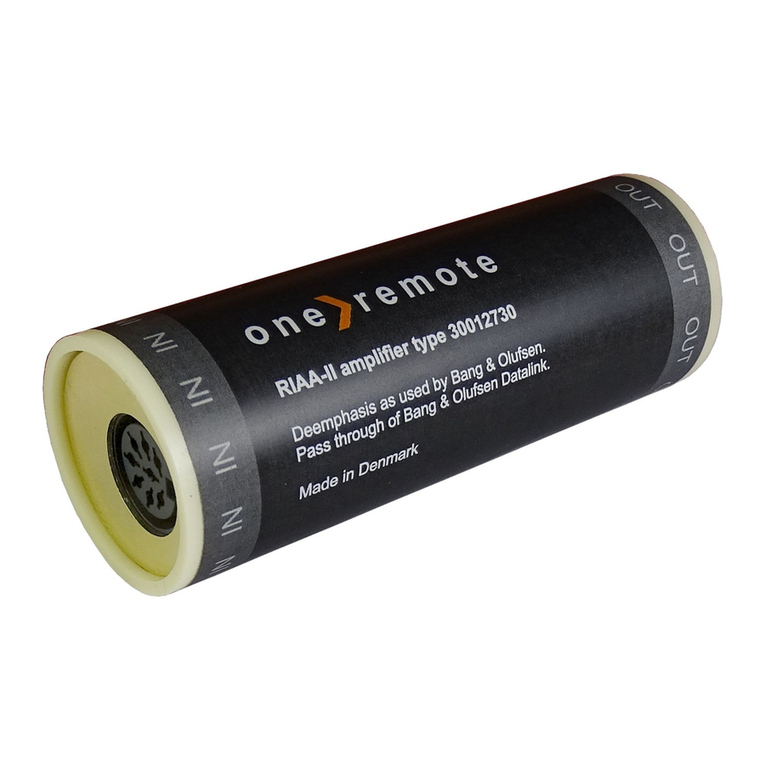
One Remote
One Remote RIAA DIN-II user manual
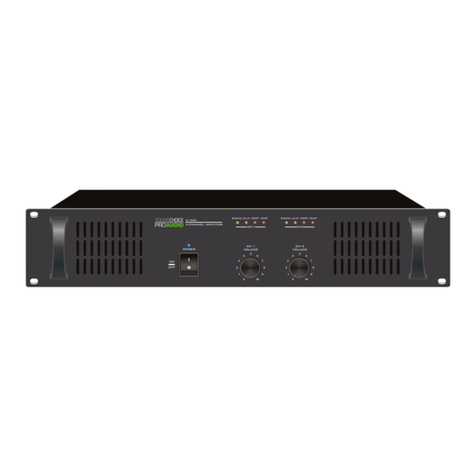
Soundchoice PROAudio
Soundchoice PROAudio 2120A Operation manual
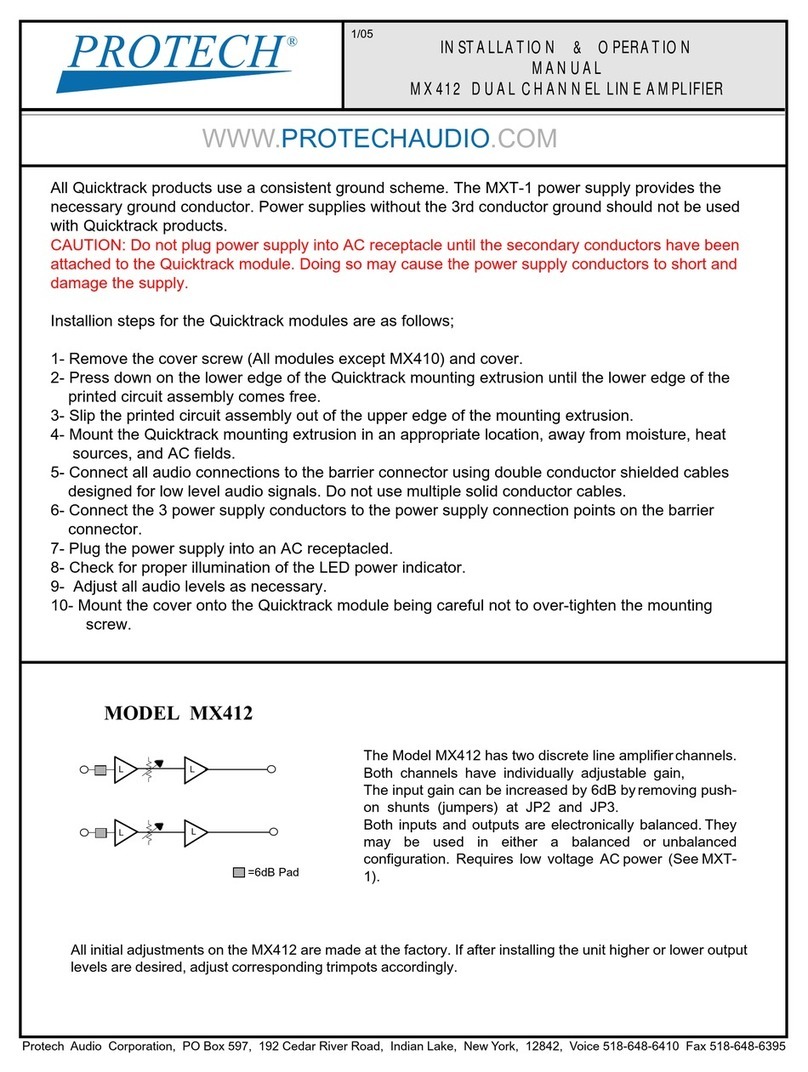
protech
protech MX412 Installation & operation manual
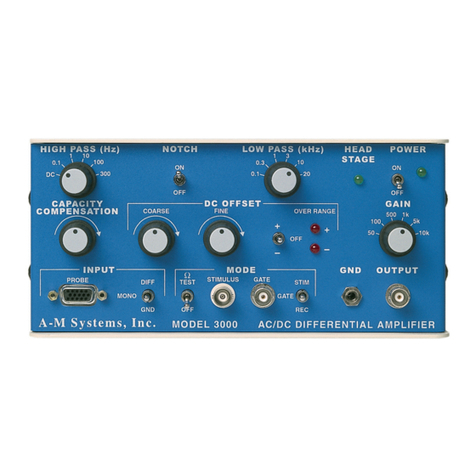
A-MSystems
A-MSystems 3000 instruction manual

Audio Control
Audio Control DIRECTOR M6400 installation manual
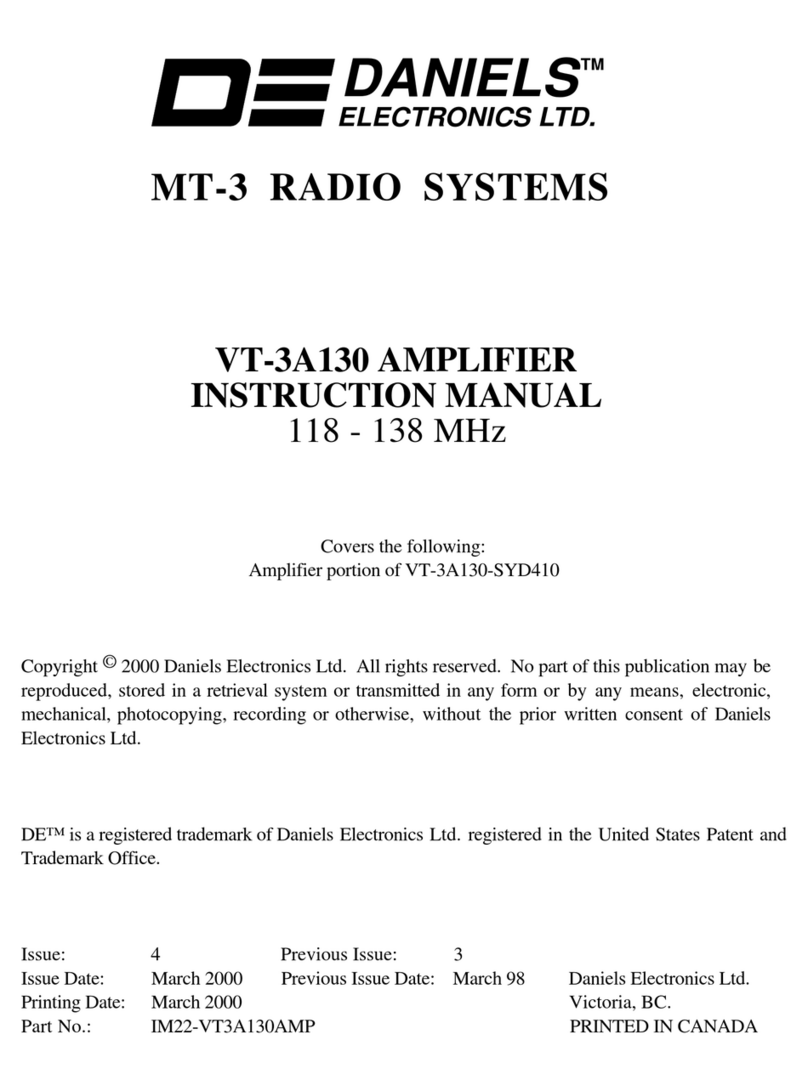
Daniels Electronics Ltd.
Daniels Electronics Ltd. VT-3A130 instruction manual
